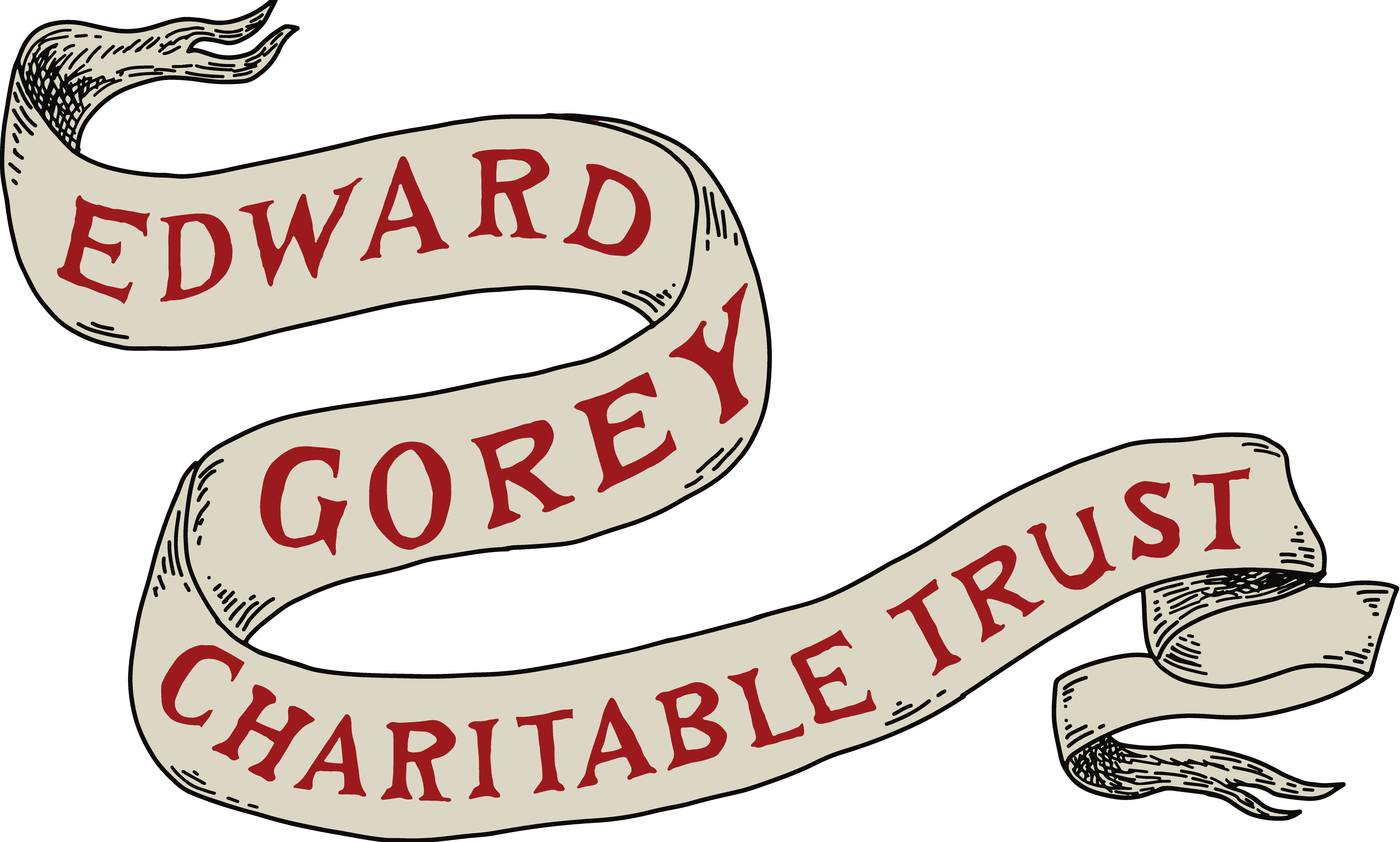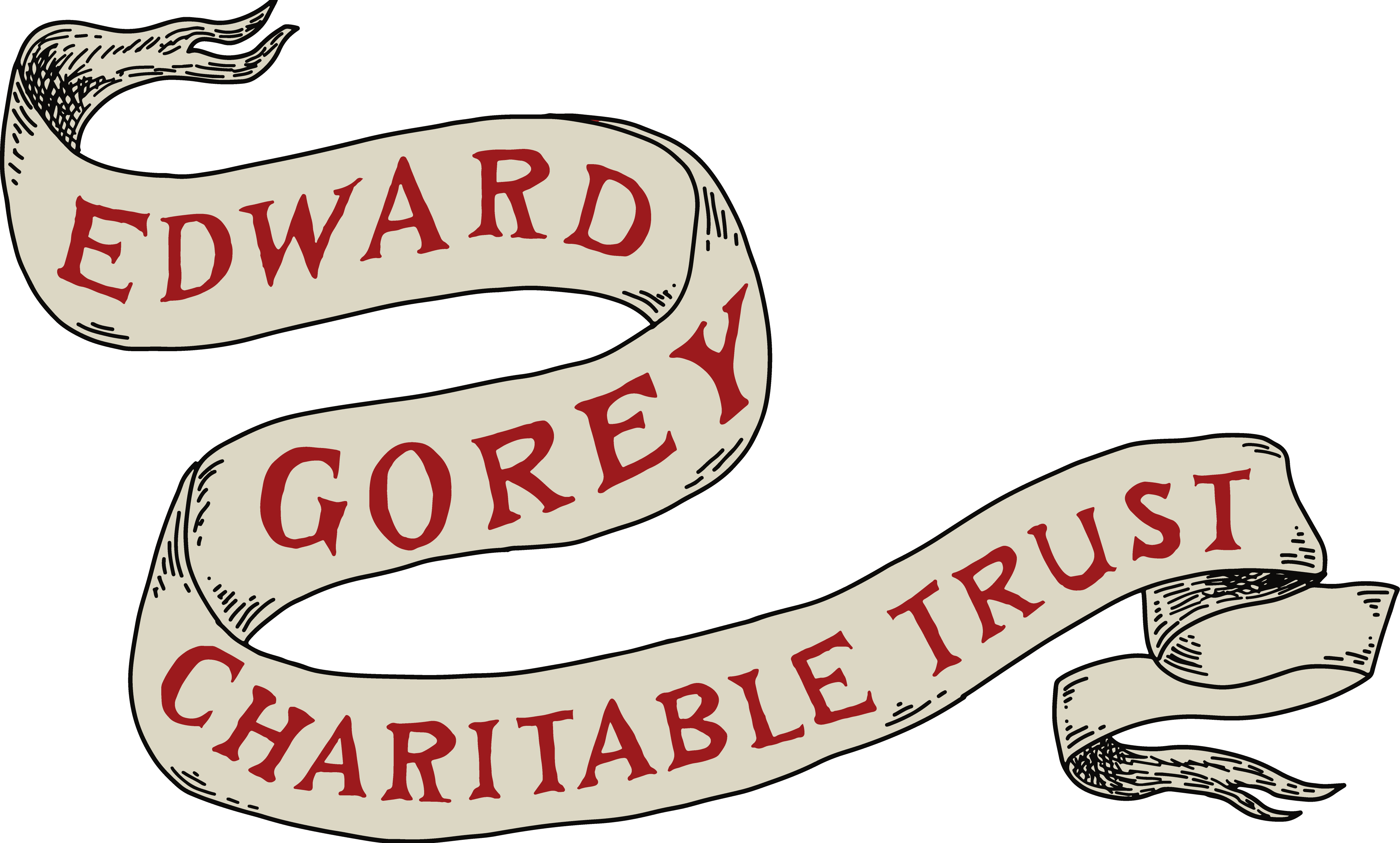The Edward Gorey Charitable Trust has partnered with writer (Gorey Secrets, Great Comic Cats) and Gorey collector Malcolm Whyte to publish articles and chapters from his most recent work, Edward Gorey Tales Explored, on our Gorey Voices blog. Over the next few months, the Trust will showcase approximately 15 articles written by Mr. Whyte, each focusing on a different book by Edward Gorey. This collaboration offers a wonderful opportunity to delve deeper into Gorey’s works through the perspective of one of his most avid followers.
The best-known, classic versions of Red Riding Hood (aka Little Red Riding Hood or Little Red Cap) were written by Charles Perrault (1628-1703) and the Brothers Grimm (1780s-1860s). A notable retelling of the folktale by Beatrice Shenk de Regniers as illustrated by Edward Gorey in expressive line art and two flat colors, red and mushroom (more about this later), brings the story up to date in humor and style.

The story opens in a humble country cottage. Red Riding Hood’s mother has baked a fresh cake and asked her daughter to take it to her ailing grandmother, but be careful going through the woods. After hurrying along, Red rested on a rock. A wolf popped up and asked her about the cake. She told the wolf about her ill grandmother and where she lives. The wolf suggested she pick some flowers to go with the cake. While Red was absorbed in gathering a bouquet, the wolf hi-tailed it to grandma’s house, entered, gobbled her up, then dove into bed disguised in her nightcap and glasses.
Shortly thereafter, Red entered the wide-open door, only to find a changed “grandma.”
“What big eyes you have, grandma,” she said.
The wolf replies, “The better to see you, my dear.”
“Grandma, what big arms you have!”
“The better to hug you, my dear.”
“Oh, Grandma, what big teeth you have!”
“The better to eat you!” he barked as he wolfed down Red — and the little cake. With a full and happy tummy, the wicked beast drifted off to a loud-snoring sleep.
A passing hunter, hearing the noise, strode into the house, saw the wolf, knifed him in the belly and out popped Red. Grandma, too. “Now, get lots of stones, whatever it takes, to fill the wolf’s belly before he awakes,” the hunter ordered. The animal woke up with a stomach full of rocks neatly sewn up by grandma. When he tried to run away he fell down dead. That was the end of the wicked wolf and the story.
As a simple folk tale told by the fire or in a colorful, illustrated book read at bedtime, Little Red Riding Hood has fascinated children for centuries. Over that time, however, it has been parsed by scholars for its deeper meaning, as a symbol of the earth’s cycle of day being swallowed by night and reborn the next morning, for example. It could also represent a child coming of age. It is a victim/predator cautionary tale or a more Freudian one of naiveite and rape. “A Postmodern Critique of the Little Red Riding Hood Tale” by Barbara Smith Reddish poses an exhaustive plunge into its allegorical meanings.[1] For a very enjoyable, uncomplicated reading, though, Gorey and de Regniers are aces.
The Writing
Beatrice Schenk de Regniers (August 1914- March, 2000) wrote nonfiction, humor, short stories, columns and fifty children’s picture books, ten of them published under the pseudonym of Tamara Kitt. Her first book was The Giant Story, a picture book published by Harper in 1953 and illustrated by friend and mutual admirer of Gorey, Maurice Sendak. In 1964 she a wrote May I Bring a Friend. Illustrated by Beni Montresor. It won the Caldecott Medal. From 1961 to 1981 she worked at Scholastic, Inc as the founding editor of its Lucky Book Club four days weekly, with Monday reserved for her own writing.
De Regniers’ version of Red Ring Hood poses none of the psychological interpretations mentioned above. Sure, Red tells the wolf where she’s going, but it’s not as if she was leading him on. Naïve though she may be, she meant well and was just being polite, as she was taught to be. Moreover, the wolf knows the woods — and everyone in it — like the back of his paw.
The story moves forward on de Regniers’ clever four-line rhyming like this:
“You must go through the woods.
I am going to worry.”
“Dear Mama,” Red Riding Hood said,
I will hurry
Or this…
The wicked wolf said,
“Red Riding Hood, Your grandma’s sick.
Don’t you think
That you should pick
some flowers for her?”
There is a musical cadence to de Regniers’ stanzas the way they are paced. We recognize a humorous touch, too, in her rhymes, abetted by a sprinkling of colloquialisms like “mama,” ‘’grandma,” “the old lady,” and “belly.” The threat — and reality — of death hovers throughout, still she sustains a light tone for an otherwise brutally bloody fable.
The Art
As mentioned above, Gorey’s setting for this folktale is rural. In the cozy cabin on page one, Red, dressed in a plain, ankle-length smock, takes her cape and hood from a hand-hewn coat rack. Thick wooden beams support the low, white-washed ceiling. The window frame and footboard of the bed are simply carved. In this otherwise spare room, a puss-in-boots doll sits on a short three-legged stool, indicative of Red’s immaturity.
The open countryside leading to Grandma’s house narrows to a path through steep dirt banks alive with trees, bushes and occasional patches of wild flowers. Grandma’s house is a homey one like Red’s. Accenting its bucolic image, it has a dense thatched roof and a forged-iron door latch.

Gorey’s design for Red Riding Hood recalls his early work for Doubleday’s Anchor books that featured black line art with two or three colors that sit solidly on the page and allow the narrative to sail along, unimpeded by elaborate hatching and cross-hatching that he has used so famously in other books.
“Mushroom”

Generally, Gorey’s color palette is subdued. It leans toward lavender, lemon yellow, olive green[2]— and mushroom. One dazzling exception to his subtle color range is his cover for Pomegranate’s 1984 engagement calendar. Red Riding Hood takes from both ends of the color spectrum pairing spots of brilliant red in larger areas of neutral mushroom.
Mushroom, as a color, is tricky to identify. Wild fungi come in many colors: gray, tan, white, red, orange, yellow, purple and blue. One can find mushroom paints that range from a hefty gray-brown “Mt. Rushmore” to a more dainty “Pashmina.” Unlike puce and mauve which have exact definitions, the color “mushroom” brings to mind Supreme Court Justice Potter Stewart’s famous attempt to define obscenity as: “I know it when I see it.”
The subject of Gorey’s mushroom color came up at a genial luncheon I had with Carol J. Verburg, author, playwright and, for more than a decade, producer and director of Gorey’s ingenious puppet performances on Cape Cod. She told me about a chance in meeting with Dennis Rosa in San Francisco in 2015. Rosa was director of Edward Gorey’s Dracula from its beginning at a little theater on Nantucket Island to its smash hit on Broadway. Discussing its staging, Verburg remembered Rosa saying: “As for the color scheme — black and white with one touch of red in each scene— that was my idea.” He wanted the production to look like 1929, including the acting style (variously described in reviews as right on target or campy). In place of just black and white, Gorey’s color choice would have included mushroom. “He was so annoyed at being overruled that the two men became estranged, speaking to each other only when necessary.” [3]
“To keep myself and the actors from growing bored or stale,” Verburg continued, “the next Spring [1997] I directed Hamlet. Edward designed the sets, in black and white and mushroom: vaguely castle-like walls of stones, finials and drapes…”[4] These stories and many more can be found in her multimedia memoir Edward Gorey On Stage (Boom-Books, 2012).
Gorey’s substantial use of mushroom color in Red Riding Hood was a wise one. It is an obliging complement to bright red, the only other color in the book. It gives weight and solidity to the trees, ground, wood, and clothing, yet it is transparent enough to support Gorey’s delicate line work, without covering it up. And its warm tone is pleasant to look at page after page.
Out of Sight
Like in a classic Greek drama, all the slaying takes place offstage in the Gorey-de Regniers’ story —what better way to make the horrid details more vivid than in the reader’s imagination? Still, there are visible clues to the murders. For instance, on the page after the wolf bounds through grandma’s cottage door, wild-eyed and tongue lolling over his bared teeth, we find him already under grandma’s quilt wearing her night cap and glasses; the French novel she was reading is flung open on the floor, a sign of the just completed struggle. The writing tells us:
So the wolf opened the door and went inside and gobbled up the Grandmother.
Similarly, after de Regniers writes,
And the wicked wolf,
Without more ado,
Ate Red Riding Hood
And the little cake, too.
We see the panting wolf casually leaning on the foot of Grandma’s bed, cake in one paw, Red’s napkin in the other. Her flower basket lies empty on the wooden floor, its bouquet wilting and scattered all over, signifying the unseen violence.
The Cast
Folktales are usually simple, but pointed, with just enough personnel to tell the story, and still give it human character. Unlike lavish, sometimes overbearing illustrated presentations of Red Riding Hood, the author and artist of this version bring its cast to life with creative economy and quiet humor. Each personality (less the kind, considerate and mildly devout mother) is summed up by Gorey in his last illustration for the book (see below).
The Hunter,tall and handsome in his dashing moustache and boots, is a kind, concerned —and fearless — neighbor. Hands on hips and no-nonsense blade tucked handily in his tunic’s belt, he stands proudly over the once wicked, predatory wolf, now as vicious as a sack of potatoes, Little Red Riding Hood clasps her hands to her heart as she stares in wistful concern over the dead animal, while grandma, dignified as always, frowns disapprovingly over the whole abrupt disturbance.
Both de Regniers and Gorey couldn’t help being influenced by the Brothers Grimm; however, in fashioning their version of the story some editing of the original ensued. Thus, in the Grimm story, Grandma cautions Red, “Here is a piece of cake and a bottle of wine. Take them to your grandmother. She is sick and weak, and they will do her well…behave yourself on the way, and do not leave the path, or you might fall down and break the glass, and then there will be nothing for your sick grandmother.”
It seems that the Bible’s teaching of “a little wine for thy stomach’s sake,”[5] was not appropriate for 20th Century children’s reading and any mention of the beverage was left out of this 1972 book. Nevertheless, De Regniers’ lyrical voice and brisk pacing keep the reader eagerly anticipating what’s coming next, while Gorey’s lively artwork coaxes the reader to linger on or turn back to a page in admiration for the rich illustration. Together, author and artist created a naturally spirited, modern classic.

By Malcom Whyte
[1] “A Postmodern Critique of the Little Red Riding Hood Tale” by Barbara Smith Reddish, University of Massachusetts Amherst, 1999
[2] Heller, Steven. p. 17, Edward Gorey His Book Cover Art & Design. 2015, Pomegranate, Portland, OR
[3] Verburg, Carol J. p.14, Edward Gorey on Stage, 2012
[4] Verburg, Carol J. p.52, Edward Gorey on Stage, 2012
[5] King James Bible, 1Timothy 5:23



